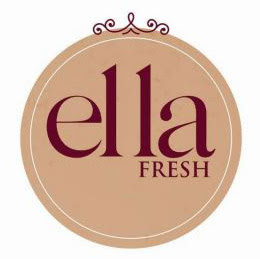The USPTO refused to register the mark ELLA FRESH in the design form shown below, for "fresh fruits and vegetables" [FRESH disclaimed], finding confusion likely with the registered mark ELLA ROSE FARM (in standard characters, ROSE FARM disclaimed) for "rose flowers; dried rose flowers for decoration; natural rose flowers; cut rose flowers; dried rose flowers; fresh edible rose flower; live rose flowers; natural rose flower; seeds for rose flowers; and wreaths of natural rose flowers." How do you think this came out? In re Innova Agri Bio Park Limited, Serial No. 88489477 (July 7, 2022) [not precedential] (Opinion by Judge Cindy B. Greenbaum).
Strength of the Cited Mark: Applicant contended that ELLA is a weak formative but did not submit any evidence of third-party use. It did submit nine third-party registrations for marks containing the word ELLA or variations thereof. However the registrations covered restaurant or food preparations services, and none related to fruits, vegetables, plants, or flowers. The Board concluded that the registred mark is entitled to the normal scope of protection.
The Marks: The Board agreed with Examining Attorney Jeffrey Oakes that ELLA is the "distinctive portion, and therefore the strongest element, of each mark." The Board found the marks to be very similar in appearance, sound connotation, and commercial impression due to this shared term. ELLA appears as the first literal portion of each mark followed by descriptive wording that indicates the category of goods. "[C]onsumers will likely view the terms FRESH and ROSE FARM in their descriptive senses rather than source-identifying elements of either mark."
The general principle that the word(s) in a word-plus-design mark are likely to make a greater impression on purchasers than the design portion applied here. Here the design element in applicant's mark, if noticed, would not be verbalized. The prominence of the word ELLA is enhanced by its placement as the initial or initial element in each mark.
The Goods: The Examining Attorney submitted printouts from a dozen third-party farms, garden centers, greenhouses, and nurseries that offer fresh fruit, produce, and live roses or other flowers, in each case under same mark. In addition, he submitted ten use-based registrations identifying these goods. Furthermore, the Internet evidence demonstrated that the involved goods travel in the same channels of trade to the same classes of consumers (the general public).
Lack of Actual Confusion: Applicant argued that the marks have "peacefully coexisted" for more than five years without any instance of actual confusion. This argument, however, was unsupported by any evidence of applicant's dates of use or of the nature and extent of use of the marks. In any case, the issue is likelihood of confusion, not actual confusion.
Conclusion: And so, the Board affirmed the refusal to register.
The content of this article is intended to provide a general guide to the subject matter. Specialist advice should be sought about your specific circumstances.

